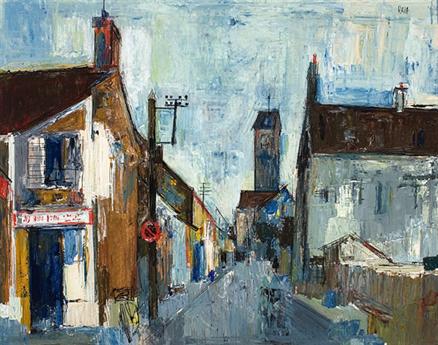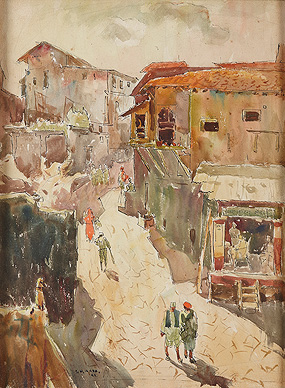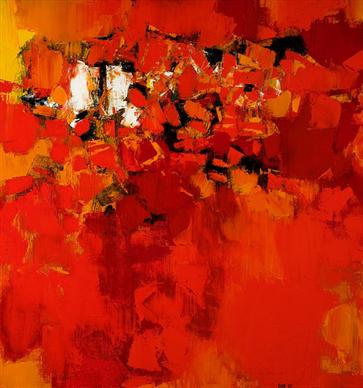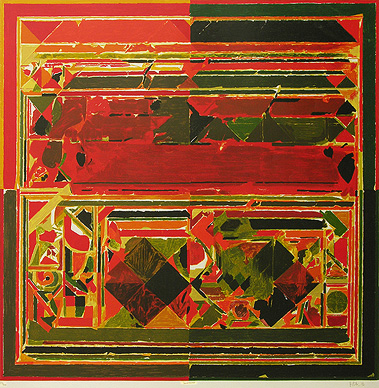
Syed Haider Raza Alias S.H. Raza (born 22 February 1922) is
an Indian artist who has lived and worked in France since 1950, but maintains
strong ties with India.[1]
His works are mainly abstracts in oil or acrylic, with a
very rich use of color, replete with icons from Indian cosmology as well as its
philosophy.[2][3] He was awarded the Padma Shri and Fellowship of the Lalit
Kala Akademi[4] in 1981, Padma Bhushan in 2007,[5] and Padma Vibhushan in
2013.[6]
He became India's priciest modern artist on 10 June 2010
when a seminal work, 'Saurashtra' by the 88-year-old sold for INR 16.42 crore
($3,486,965) at a Christie's auction.
Syed Haider Raza was born in Babaria,[8] Mandla district,
Madhya Pradesh.
He completed his school education from Government High
School, Damoh.M.P
After high school, he studied further at the Nagpur School
of Art, Nagpur (1939–43), followed by Sir J. J. School of Art, Bombay
(1943–47),[13] before moving to France in October 1950 to study at the École
nationale supérieure des Beaux-Arts (ENSB-A) in Paris, 1950-1953 on a Govt. of
France scholarship.[14] After his studies, he travelled across Europe, and
continued to live and exhibit his work in Paris.[12] He was later awarded the
Prix de la critique in Paris in 1956, becoming the first non-French artist to
receive the honour.
ARTWORK DETAILS
S H Raza
Flora Fountain in Monsoon
Signed in English (lower right)
Watercolor and gouache on paper pasted on board
1945
21 x 24.5 in | 53.3 x 62.2 cm
Category: Painting
Style: Landscape
|
 |
|
 |
S H Raza
Untitled
1947
Watercolor on paper
19 x 14 in | 48.3 x 35.6 cm
Signed and dated in English (lower left)
Category: Painting
Style: LandscapeSyed Haider Raza, has his first solo show in 1946 at Bombay Art Society Salon, and was awarded the Silver Medal of the society.[9] |
His work evolved from painting expressionistic landscapes to
abstract ones. From his fluent water colours of landscapes and townscapes
executed in the early 40's he moved towards a more expressive language painting
landscapes of the mind.
Once in France, he continued to experiment with currents of
Western Modernism moving from Expressionist modes towards greater abstraction
and eventually incorporating elements of Tantrism from Indian
scriptures.[17][18][19] Whereas his fellow contemporaries dealt with more
figural subjects, Raza chose to focus on landscapes in the 1940s and 50s, inspired
in part by a move to the France.
In 1959, he married French artist, Janine Mongillat, and
three years later, in 1962, he became a visiting lecturer at the University of
California in Berkeley, USA.[20] Raza was initially enamored of the bucolic
countryside of rural France. Eglise is part of a series which captures the
rolling terrain and quaint village architecture of this region. Showing a
tumultuous church engulfed by an inky blue night sky, Raza uses gestural
brushstrokes and a heavily impasto-ed application of paint, stylistic devices
which hint at his later 1970s abstractions.
 |
ARTWORK DETAILS
S H Raza
Trishna
Signed and dated in English (lower right and verso)
Oil on canvas
1962
30 x 28.5 in | 76.2 x 72.4 cm
Category: Painting
Style: Abstract |
By the 1970s Raza had grown increasingly unhappy and
restless with his own work and wanted to find a new direction and deeper
authenticity in his work, and move away from what he called the 'plastic art'.
His trips to India, especially to caves of Ajanta - Ellora, followed by those
to Benaras, Gujarat and Rajasthan, made him realise his ro and study Indian
culture more closely, the result was 'Bindu',[21] which signified his rebirth
as a painter.[22] The Bindu came forth in 1980, and took his work deeper and
brought in, his new-found Indian vision and Indian ethnography. One of the reasons
he attributes to the origin of the 'Bindu', have been his elementary school
teacher, who on finding him lacking adequate concentration, drew a dot on the
blackboard and asked him to concentrate on it.[23]
 |
S.H. Raza (B.1922)
Aarakta Shyam, 2012
Acrylic on canvas
100 x 100 cm
(39.5 x 39.5 in.)
|
 |
S.H. Raza (B.1922)
Yugal, 2011
Acrylic on canvas
100 x 100cm.
|
 |
| S.H. Raza (B.1922) Sagar, 2012 Acrylic on canvas 60 x 60cm. |
 |
S.H. Raza (B.1922)
Yoni, 2012
Acrylic on canvas
50 x 50 cm
(20 x 20 in.) |
 |
| S.H. Raza (B.1922) Bindu Vistaar, 2012 Acrylic on canvas 100 x 200 cm (39.5 x 78.5 in.) |
Source - GROSVENOR GALLERY
 |
S.H. Raza
Germination Acrylic on canvas 59" x 59" 1994 |
 |
| Rajasthan |
 |
| Rajasthan, 1984 , Acralic on Canvas Rajasthan, is a large dazzling canvas (175x175 cm) in which dramatic blacks, oranges and greens predominate. |
 |
| 2012 From the limited edition of 100 Other editions from this series will also be available for purchase Please note: the edition number may differ from the one mentioned on the image Signed and dated in English (lower right) Serigraphy on paper Printed area size: 54 x 54 in (137 x 137 cm) Sheet area size: 60 x 60 in (152.4 x 152.4 cm) Sold at Rs 2,55,000 |
“ "My
work is my own inner experience and involvement with the mysteries of nature
and form which is expressed in colour, line, space and light".
- S. H. Raza ”
The unique energy vibrating with colour in his early
landscapes are now more subtle but equally, if not more, dynamic. Raza
abandoned the expressionistic landscape for a geometric abstraction and the
'Bindu'.[4] Raza perceives the Bindu as the center of creation and existence
progressing towards forms and colour as well as energy, sound, space and time.
His work took another leap in 2000, when he began to express
his increasingly deepened insights and thoughts on Indian spiritual, and
created works around the Kundalini, Nagas and the Mahabharat.[21]
No comments:
Post a Comment